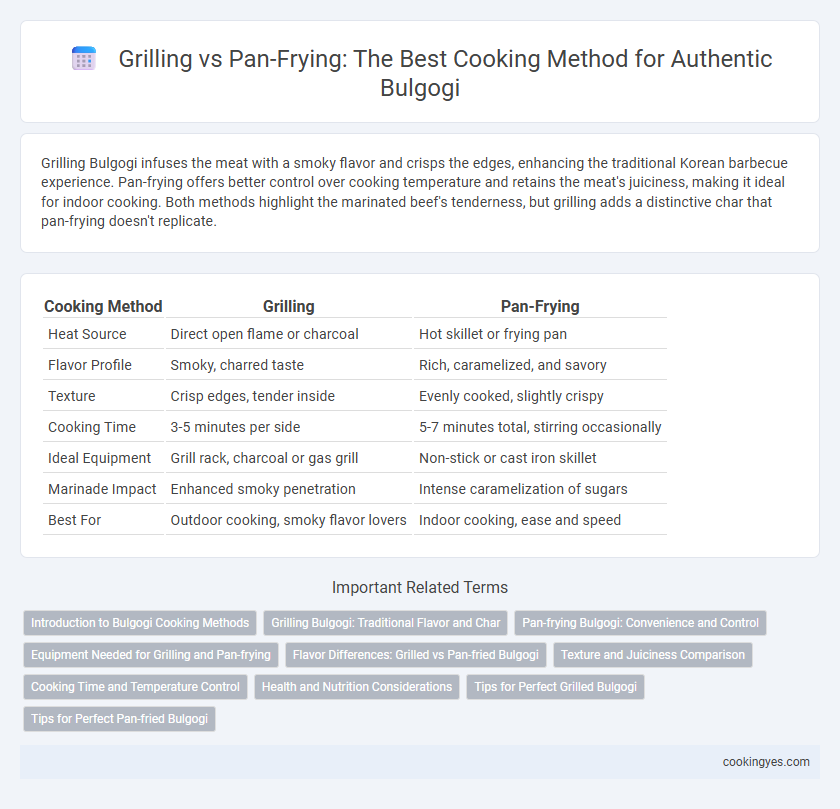Grilling Bulgogi infuses the meat with a smoky flavor and crisps the edges, enhancing the traditional Korean barbecue experience. Pan-frying offers better control over cooking temperature and retains the meat's juiciness, making it ideal for indoor cooking. Both methods highlight the marinated beef's tenderness, but grilling adds a distinctive char that pan-frying doesn't replicate.
Table of Comparison
| Cooking Method | Grilling | Pan-Frying |
|---|---|---|
| Heat Source | Direct open flame or charcoal | Hot skillet or frying pan |
| Flavor Profile | Smoky, charred taste | Rich, caramelized, and savory |
| Texture | Crisp edges, tender inside | Evenly cooked, slightly crispy |
| Cooking Time | 3-5 minutes per side | 5-7 minutes total, stirring occasionally |
| Ideal Equipment | Grill rack, charcoal or gas grill | Non-stick or cast iron skillet |
| Marinade Impact | Enhanced smoky penetration | Intense caramelization of sugars |
| Best For | Outdoor cooking, smoky flavor lovers | Indoor cooking, ease and speed |
Introduction to Bulgogi Cooking Methods
Grilling Bulgogi enhances its smoky flavor and creates a caramelized exterior, ideal for traditional Korean barbecue experiences. Pan-frying offers a convenient indoor alternative, allowing precise control over heat and ensuring a tender, juicy texture by cooking marinated beef slices evenly. Both methods emphasize balancing high heat and quick cooking to preserve Bulgogi's signature sweet and savory taste.
Grilling Bulgogi: Traditional Flavor and Char
Grilling Bulgogi preserves its traditional smoky and charred flavors, enhancing the marinated beef's caramelization and tenderness through direct high heat. This method allows fat to drip away, creating a crisp texture while infusing the meat with a subtle smoky aroma unique to open flame cooking. Authentic Korean barbecue experience relies on grilling Bulgogi to achieve its signature char and depth of flavor not replicated by pan-frying.
Pan-frying Bulgogi: Convenience and Control
Pan-frying Bulgogi offers unmatched convenience and precise temperature control, allowing for even cooking and caramelization of the marinated beef. This method requires less equipment and minimal preparation, making it ideal for indoor cooking and quick meals. Pan-frying also helps retain the juices and enhances the intense flavors of the soy-based marinade, ensuring a tender and flavorful dish every time.
Equipment Needed for Grilling and Pan-frying
Grilling bulgogi requires a barbecue grill or outdoor grill with a stable heat source, often using charcoal or gas for authentic smoky flavor, along with tongs and a grill brush for maintenance. Pan-frying bulgogi only needs a non-stick skillet or cast-iron pan and a stovetop burner, providing more control over cooking temperature and ease of seasoning retention. Each method benefits from specific equipment that influences the texture and taste of the marinated beef slices.
Flavor Differences: Grilled vs Pan-fried Bulgogi
Grilling bulgogi imparts a smoky, charred flavor that enhances the marinade's sweetness and adds a depth of complexity. Pan-frying bulgogi preserves the meat's tenderness and concentrates the sauce's caramelized notes, creating a richer, more intense taste. The choice between grilling and pan-frying significantly influences the final flavor profile, with grilling offering a smokier aroma and pan-frying delivering a buttery, umami-rich experience.
Texture and Juiciness Comparison
Grilling Bulgogi imparts a smoky flavor and creates a slightly charred, crispy exterior while maintaining a tender, juicy interior due to the high direct heat. Pan-frying Bulgogi allows for more even cooking and caramelization with a softer texture, though it can sometimes result in less juiciness as excess moisture evaporates on the stove. Both methods enhance Bulgogi's savory taste, but grilling excels in crisp texture and juiciness retention, whereas pan-frying delivers a more uniformly tender bite.
Cooking Time and Temperature Control
Grilling bulgogi allows for higher, consistent temperatures that quickly caramelize the marinated beef, usually cooking it in 2-3 minutes per side. Pan-frying offers more precise temperature control, enabling slower cooking at medium heat to preserve tenderness and avoid overcooking. Optimal cooking times range from 5 to 7 minutes on a stovetop, balancing caramelization and juiciness.
Health and Nutrition Considerations
Grilling Bulgogi allows excess fat to drip away, reducing overall calorie content and promoting a leaner dish rich in protein and iron. Pan-frying retains more fat, which can increase calorie intake but also preserves flavorful juices and nutrients like B vitamins. Choosing grilling minimizes unhealthy fat consumption, supporting heart health and weight management while maintaining essential nutrients.
Tips for Perfect Grilled Bulgogi
For perfect grilled Bulgogi, marinate thinly sliced beef in a balanced mixture of soy sauce, sugar, garlic, and sesame oil to enhance flavor and tenderness. Use a charcoal grill or cast-iron grill pan to achieve a smoky, caramelized crust while keeping the meat juicy. Maintain high heat and avoid overcrowding the grill to ensure even cooking and prevent steaming.
Tips for Perfect Pan-fried Bulgogi
Pan-frying bulgogi requires maintaining medium-high heat to achieve a caramelized exterior while keeping the meat tender and juicy. Use a thin layer of oil and avoid overcrowding the pan to ensure even cooking and a flavorful crust. Let the meat rest briefly after pan-frying for the juices to redistribute, enhancing its savory taste and texture.
Grilling vs Pan-frying for Bulgogi cooking method Infographic

 cookingyes.com
cookingyes.com